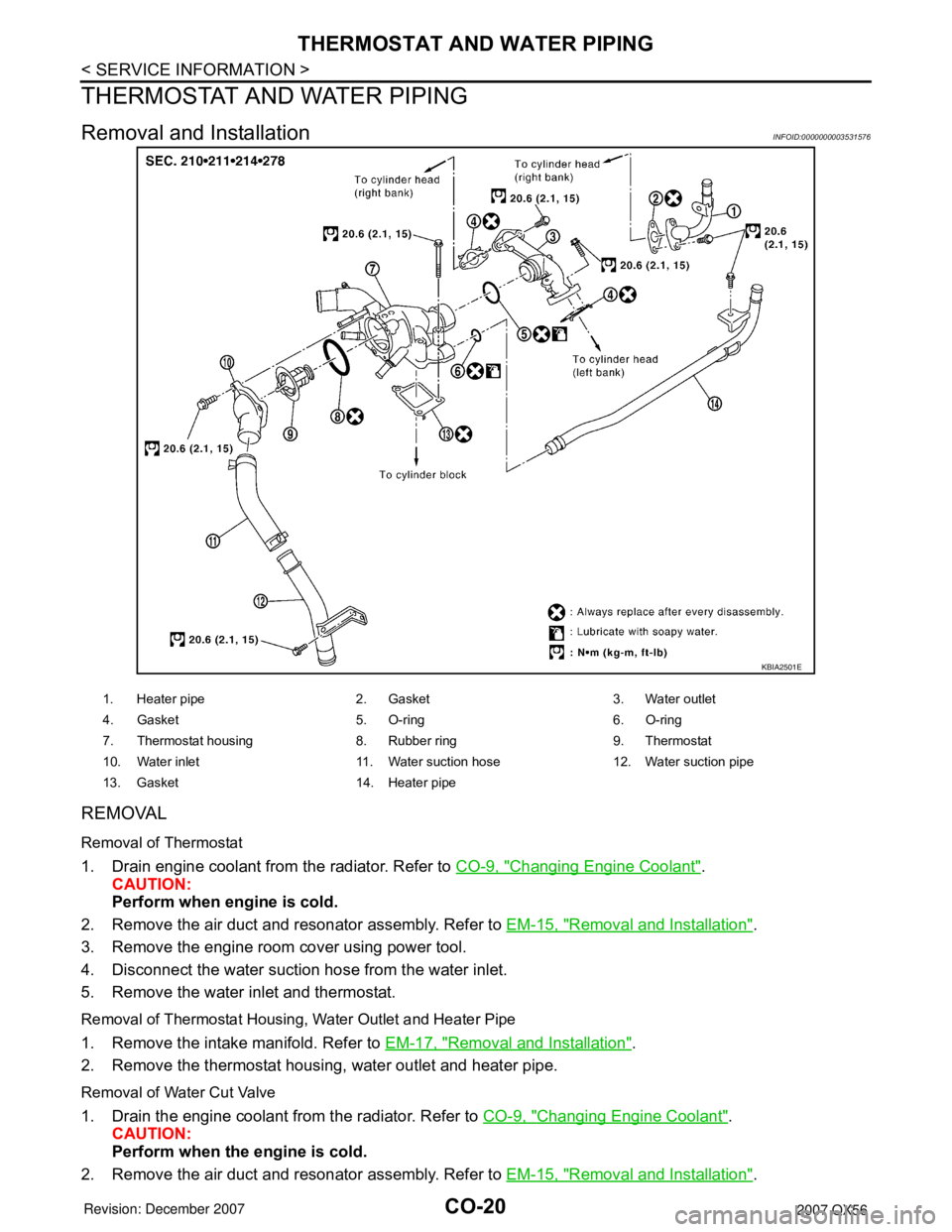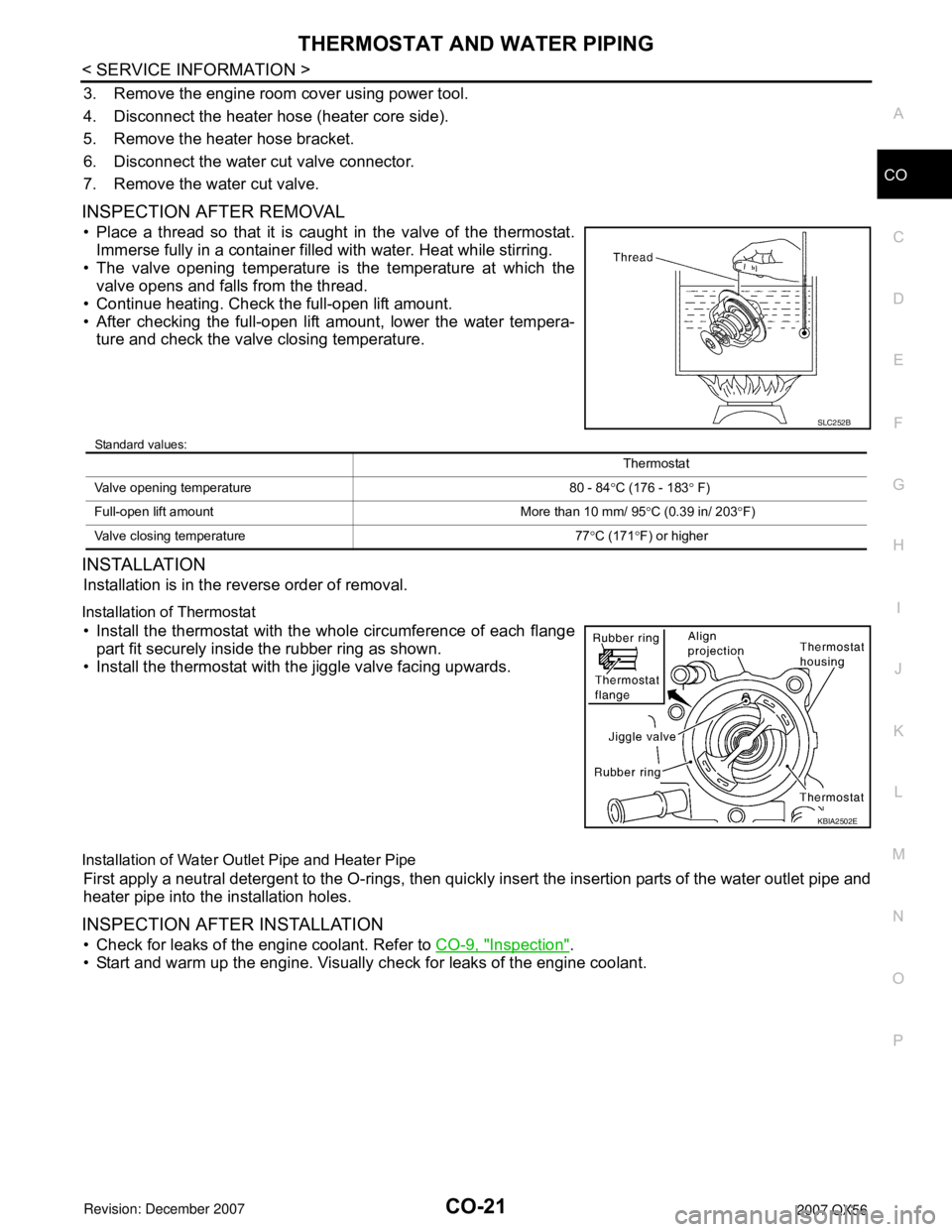2007 INFINITI QX56 heater
[x] Cancel search: heaterPage 534 of 3061

ATC-164
< SERVICE INFORMATION >
REFRIGERANT LINES
4. Remove the evaporator.
INSTALLATION
Installation is in the reverse order of removal.
CAUTION:
Replace the O-rings on the low-pressure flexible hose and the hi gh-pressure pipe with new ones.
Apply compressor oil to the O- rings when installing them.
Removal and Installation for Rear EvaporatorINFOID:0000000003533304
Rear Heater and Cooling Unit Assembly
REMOVAL
1. Remove the rear heater and cooling unit assembly from the vehicle. Refer\
to ATC-133, "Removal and
Installation".
2. Remove the rear blower motor.
LJIA0135E
1. Front cover 2. Evaporator and heater core case 3. Evaporator
4. Side cover 5. Heater core 6. Rear blower motor
7. Blower motor case 8. Rear blower motor resistor
Page 535 of 3061

REFRIGERANT LINESATC-165
< SERVICE INFORMATION >
C
DE
F
G H
I
K L
M A
B
AT C
N
O P
3. Remove the rear blower speed resistor.
4. Remove the rear air mix door motor.
5. Remove the rear duct and blend door assembly. Refer to AT C -
148, "Removal and Installation".
6. Disassemble the rear heater and cooling unit assembly to remove the evaporator.
INSTALLATION
Installation is in the reverse order of removal.
CAUTION:
• Replace the O-rings on the rear A/C pipes with ne w ones. Apply compressor oil to the O-rings when
installing them.
• After charging refrigerant, check for leaks.
Removal and Installation for Front Expansion ValveINFOID:0000000003533305
REMOVAL
1. Discharge the refrigerant. Refer to ATC-150, "HFC-134a (R-134a) Service Procedure".
2. Remove the front evaporator. Refer to ATC-163, "
Removal and Installation for Front Evaporator".
3. Remove the cooler grommet.
4. Remove the expansion valve.
INSTALLATION
Installation is in the reverse order of removal.
CAUTION:
• Replace the O-rings on the A/C re frigerant pipes with new ones, then apply compressor oil to them
when installing them.
• After charging refrigerant, check for leaks.
Removal and Installation for Rear Expansion ValveINFOID:0000000003533306
REMOVAL
1. Discharge the refrigerant. Refer to ATC-150, "HFC-134a (R-134a) Service Procedure".
2. Remove the luggage side lower finisher RH. Refer to EI-39
.
3. Disconnect the A/C refrigerant pi pes from the expansion valve.
CAUTION:
Cap or wrap the A/C refrigerant pipe ends with a suitable material such as vinyl tape to avoid the
entry of air and contaminants.
4. Remove the expansion valve.
LJIA0021E
WJIA0582E
Expansion valve bolts : 4 N·m (0.41 kg-m, 35 in-lb)
A/C refrigerant pipe to expansion valve bolt : Refer to ATC-152, "
Component".
Page 538 of 3061

ATC-168
< SERVICE INFORMATION >
REFRIGERANT LINES
3. Move the probe along each component at a speed of approxi-mately 25 - 50 mm (1 - 2 in)/second as shown.
CHECKING PROCEDURE
NOTE:
To prevent inaccurate or false readings, make sure t here is no refrigerant vapor, shop chemicals, or cigarette
smoke in the vicinity of the vehicle. Perform the leak test in a calm area (low air/wind movement) so that \
the
leaking refrigerant is not dispersed.
1. Turn the engine OFF.
2. Connect the manifold gauge set (J-39183-C) to the A/C service ports. Refer to ATC-150, "
HFC-134a (R-
134a) Service Procedure".
3. Check if the A/C refrigerant pressure is at least 345 kPa (3.52 kg/cm
2 , 50 psi) above a temperature of
16 °C (61 °F). If less than specification, recover/evacuat e and recharge the system with the specified
amount of refrigerant. Refer to ATC-150, "
HFC-134a (R-134a) Service Procedure".
NOTE:
At temperatures below 16 °C (61 °F), leaks may not be detected since the system may not reach 345 kPa
(3.52 kg/cm
2 , 50 psi) pressure.
4. Perform the leak test from the high-pressure side (front A/C compressor discharge “a” to evaporator inlet
“f” or rear piping connection “l”) to the low-pressure side (front A/C evaporator drain hose “g” to shaft seal
“k” and rear A/C evaporator drain hose “o” to piping connection “r”). Refer to ATC-152, "
Component".
Clean the component to be checked and carefully move the electronic refrigerant leak detector probe
completely around the following connections and components.
• Check the compressor shaft seal
• Check the high and low-pressure pipe and hose fittings, relief valve, and compressor shaft seal
• Check the liquid tank
• Check the refrigerant pressure sensor
• Check all around the service valves. Check that the service valve caps are screwed tightly on the ser-
vice valves (to prevent leaks).
NOTE:
After removing manifold gauge set (J-39183-C) from the service valves, wipe any residue from the ser-
vice valves to prevent any false readings by the electronic refrigerant leak detector (J-41995).
• Evaporator
With engine OFF, turn blower fan on “High” for at l east 15 seconds to dissipate any refrigerant trace in
the heater and cooling unit assembly. Wait a minimum of 10 minutes accumulation time (refer to the
manufacturer's recommended procedure for actual wait time) before inserting the electronic refrigerant
leak detector probe into the heater and cooling unit assembly drain hose.
NOTE:
Keep the probe inserted for at least 10 seconds. Use c aution not to contaminate the probe tip with water
or dirt that may be in the drain hose.
5. If a leak is detected, verify at least once by blow ing compressed air into the area of the suspected leak,
then repeat the leak check.
6. Do not stop when one leak is found. Continue to c heck for additional leaks at all system components and
connections.
7. If no leaks are found, perform steps 8 - 11.
8. Start the engine.
9. Set the heater A/C controls as follows: NOTE:
For the automatic system, turn OF F the automatic controls and set the heater A/C controls manually.
a. A/C switch to ON
SHA708EA
Page 571 of 3061

AUDIO
AV-31
< SERVICE INFORMATION >
C
D
E
F
G
H
I
J
L
MA
B
AV
N
O
P
• Loss of power to the satellite radio tuner (factory installed)
• Open or short in the REQ1, TXD, or RXD circuits.
If the satellite antenna is disconnected or inoperative, the display unit will display ANTENNA.
Noise InspectionINFOID:0000000003533674
The vehicle itself can be a source of noise if noise prevention parts or electrical equipment is malfunctioning.
Check if noise is caused and/or changed by engine speed, ignition switch turned to each position, and opera-
tion of each piece of electrical equipment, and determine the cause.
NOTE:
The source of the noise can be found easily by listening to the noise while removing the fuses of electrical
components, one by one.
TYPE OF NOISE AND POSSIBLE CAUSE
Power Supply Circuit InspectionINFOID:0000000003533675
1.CHECK FUSES
Check that the following fuses are not blown.
OK or NG
OK >> GO TO 2.
NG >> If fuse is blown, be sure to eliminate cause of blown fuse before installing new fuse. Refer to PG-
3.
2.POWER SUPPLY CIRCUIT CHECK
1. Disconnect audio unit connector M43, subwoofer connector B72 and BOSE speaker amp. connector
M112.
2. Check voltage between the audio unit and ground.
Occurrence condition Possible cause
Occurs only when engine is ON.A continuous growling noise occurs. The speed of
the noise varies with changes in the engine speed.• Ignition components
A whistling noise occurs while the engine speed is
high. A booming noise occurs while the engine is
running and the lighting switch is ON.• Generator
The occurrence of the noise is linked with the operation of the fuel pump. • Fuel pump condenser
Noise only occurs when various
electrical components are oper-
ating.A cracking or snapping sound occurs with the op-
eration of various switches.• Relay malfunction, audio unit malfunction
The noise occurs when various motors are operat-
ing.• Motor case ground
•Motor
The noise occurs constantly, not just under certain conditions.• Rear defogger coil malfunction
• Open circuit in printed heater
• Poor ground of antenna amplifier or anten-
na feeder line
A cracking or snapping sound occurs while the vehicle is being driven, especially when
it is vibrating excessively.• Ground wire of body parts
• Ground due to improper part installation
• Wiring connections or a short circuit
Unit Terminals Signal name Fuse No.
Audio unit6 Battery power 31
10 Ignition switch ACC or ON 4
AV switch1 Battery power 31
2 Ignition switch ACC or ON 4
BOSE speaker amp. 1 Battery power 31
Subwoofer 6 Battery power 17
Page 999 of 3061

CO-10
< SERVICE INFORMATION >
ENGINE COOLANT
• Wrap a thick cloth around the cap to carefully remove the cap. First, turn the cap a quarter of a turn
to release any built-up pressure, then push down and turn the cap all the way to remove it.
DRAINING ENGINE COOLANT
1. Turn ignition switch ON and set temperature control lever all the way to HOT position or the highest tem-
perature position. Wait 10 seconds and turn ignition switch OFF.
2. Remove the engine front undercover using power tool.
3. Open the radiator drain plug at the bottom of the radiator, and
remove the radiator filler cap. This is the only step required
when partially draining the cooling system (radiator only).
CAUTION:
Do not to allow the coolant to contact the drive belts.
4. When draining all of the coolant in the system for engine
removal or repair, it is necessary to drain the cylinder block.
Remove the RH cylinder block drain plug to drain the right bank
and the oil cooler hose to drain the left bank as shown.
5. Remove the reservoir tank to drain the engine coolant, then clean the reservoir tank before installing it.
6. Check the drained coolant for contaminants such as rust, corrosion or discoloration.
If the coolant is contaminated, flush the engine cooling system.
REFILLING ENGINE COOLANT
1. Close the radiator drain plug. Install the reservoir tank, cylinder block drain plug, and the oil cooler hose, if
removed for a total system drain or for engine removal or repair.
• The radiator must be completely empty of coolant and water.
• Apply sealant to the threads of the cylinder block drain plug. Use Genuine High Performance Thread
Sealant or equivalent. Refer to GI-45, "
Recommended Chemical Product and Sealant".
2. Set the vehicle heater controls to the full HOT and heater ON position. Turn the vehicle ignition ON with
the engine OFF as necessary to activate the heater mode.
WBIA0391E
PBIC0146E
WBIA0392E
Radiator drain plug : Refer to CO-13, "Removal and Installation".
RH cylinder block drain plug : Refer to EM-78
.
Page 1009 of 3061

CO-20
< SERVICE INFORMATION >
THERMOSTAT AND WATER PIPING
THERMOSTAT AND WATER PIPING
Removal and InstallationINFOID:0000000003531576
REMOVAL
Removal of Thermostat
1. Drain engine coolant from the radiator. Refer to CO-9, "Changing Engine Coolant".
CAUTION:
Perform when engine is cold.
2. Remove the air duct and resonator assembly. Refer to EM-15, "
Removal and Installation".
3. Remove the engine room cover using power tool.
4. Disconnect the water suction hose from the water inlet.
5. Remove the water inlet and thermostat.
Removal of Thermostat Housing, Water Outlet and Heater Pipe
1. Remove the intake manifold. Refer to EM-17, "Removal and Installation".
2. Remove the thermostat housing, water outlet and heater pipe.
Removal of Water Cut Valve
1. Drain the engine coolant from the radiator. Refer to CO-9, "Changing Engine Coolant".
CAUTION:
Perform when the engine is cold.
2. Remove the air duct and resonator assembly. Refer to EM-15, "
Removal and Installation".
KBIA2501E
1. Heater pipe 2. Gasket 3. Water outlet
4. Gasket 5. O-ring 6. O-ring
7. Thermostat housing 8. Rubber ring 9. Thermostat
10. Water inlet 11. Water suction hose 12. Water suction pipe
13. Gasket 14. Heater pipe
Page 1010 of 3061

THERMOSTAT AND WATER PIPING
CO-21
< SERVICE INFORMATION >
C
D
E
F
G
H
I
J
K
L
MA
CO
N
P O
3. Remove the engine room cover using power tool.
4. Disconnect the heater hose (heater core side).
5. Remove the heater hose bracket.
6. Disconnect the water cut valve connector.
7. Remove the water cut valve.
INSPECTION AFTER REMOVAL
• Place a thread so that it is caught in the valve of the thermostat.
Immerse fully in a container filled with water. Heat while stirring.
• The valve opening temperature is the temperature at which the
valve opens and falls from the thread.
• Continue heating. Check the full-open lift amount.
• After checking the full-open lift amount, lower the water tempera-
ture and check the valve closing temperature.
Standard values:
INSTALLATION
Installation is in the reverse order of removal.
Installation of Thermostat
• Install the thermostat with the whole circumference of each flange
part fit securely inside the rubber ring as shown.
• Install the thermostat with the jiggle valve facing upwards.
Installation of Water Outlet Pipe and Heater Pipe
First apply a neutral detergent to the O-rings, then quickly insert the insertion parts of the water outlet pipe and
heater pipe into the installation holes.
INSPECTION AFTER INSTALLATION
• Check for leaks of the engine coolant. Refer to CO-9, "Inspection".
• Start and warm up the engine. Visually check for leaks of the engine coolant.
SLC252B
Thermostat
Valve opening temperature 80 - 84°C (176 - 183° F)
Full-open lift amount More than 10 mm/ 95°C (0.39 in/ 203°F)
Valve closing temperature 77°C (171°F) or higher
KBIA2502E
Page 1085 of 3061

EC-2
CONSULT-II Function (ENGINE) ..........................111
Generic Scan Tool (GST) Function .......................122
CONSULT-II Reference Value in Data Monitor
Mode ......................................................................
124
Major Sensor Reference Graph in Data Monitor
Mode ......................................................................
127
TROUBLE DIAGNOSIS - SPECIFICATION
VALUE .............................................................
129
Description .............................................................129
Testing Condition ...................................................129
Inspection Procedure .............................................129
Diagnosis Procedure .............................................130
TROUBLE DIAGNOSIS FOR INTERMITTENT
INCIDENT ........................................................
138
Description .............................................................138
Diagnosis Procedure .............................................138
POWER SUPPLY AND GROUND CIRCUIT ...139
Wiring Diagram ......................................................139
Diagnosis Procedure .............................................140
Ground Inspection .................................................143
DTC U1000, U1001 CAN COMMUNICATION
LINE .................................................................
145
Description .............................................................145
On Board Diagnosis Logic .....................................145
DTC Confirmation Procedure ................................145
Wiring Diagram ......................................................146
Diagnosis Procedure .............................................146
DTC U1010 CAN COMMUNICATION .............147
Description .............................................................147
On Board Diagnosis Logic .....................................147
DTC Confirmation Procedure ................................147
Diagnosis Procedure .............................................147
DTC P0011, P0021 IVT CONTROL .................149
Description .............................................................149
CONSULT-II Reference Value in Data Monitor
Mode ......................................................................
150
On Board Diagnosis Logic .....................................150
DTC Confirmation Procedure ................................150
Wiring Diagram ......................................................152
Diagnosis Procedure .............................................155
Component Inspection ...........................................159
Removal and Installation .......................................160
DTC P0031, P0032, P0051, P0052 A/F SEN-
SOR 1 HEATER ...............................................
163
Description .............................................................163
CONSULT-II Reference Value in Data Monitor
Mode ......................................................................
163
On Board Diagnosis Logic .....................................163
DTC Confirmation Procedure ................................163
Wiring Diagram ......................................................164
Diagnosis Procedure .............................................167
Component Inspection ...........................................168
Removal and Installation .......................................169
DTC P0037, P0038, P0057, P0058 HO2S2
HEATER ...........................................................
170
Description ............................................................170
CONSULT-II Reference Value in Data Monitor
Mode .....................................................................
170
On Board Diagnosis Logic ....................................170
DTC Confirmation Procedure ................................170
Wiring Diagram .....................................................172
Diagnosis Procedure .............................................175
Component Inspection ..........................................176
Removal and Installation .......................................177
DTC P0075, P0081 IVT CONTROL SOLE-
NOID VALVE ....................................................
178
Component Description ........................................178
CONSULT-II Reference Value in Data Monitor
Mode .....................................................................
178
On Board Diagnosis Logic ....................................178
DTC Confirmation Procedure ................................178
Wiring Diagram .....................................................179
Diagnosis Procedure .............................................182
Component Inspection ..........................................183
Removal and Installation .......................................184
DTC P0101 MAF SENSOR ..............................186
Component Description ........................................186
CONSULT-II Reference Value in Data Monitor
Mode .....................................................................
186
On Board Diagnosis Logic ....................................186
DTC Confirmation Procedure ................................186
Overall Function Check .........................................188
Wiring Diagram .....................................................189
Diagnosis Procedure .............................................190
Component Inspection ..........................................192
Removal and Installation .......................................193
DTC P0102, P0103 MAF SENSOR ..................194
Component Description ........................................194
CONSULT-II Reference Value in Data Monitor
Mode .....................................................................
194
On Board Diagnosis Logic ....................................194
DTC Confirmation Procedure ................................194
Wiring Diagram .....................................................196
Diagnosis Procedure .............................................197
Component Inspection ..........................................199
Removal and Installation .......................................200
DTC P0112, P0113 IAT SENSOR ....................201
Component Description ........................................201
On Board Diagnosis Logic ....................................201
DTC Confirmation Procedure ................................201
Wiring Diagram .....................................................202
Diagnosis Procedure .............................................202
Component Inspection ..........................................204
Removal and Installation .......................................204
DTC P0117, P0118 ECT SENSOR ...................205
Component Description ........................................205
On Board Diagnosis Logic ....................................205
DTC Confirmation Procedure ................................206